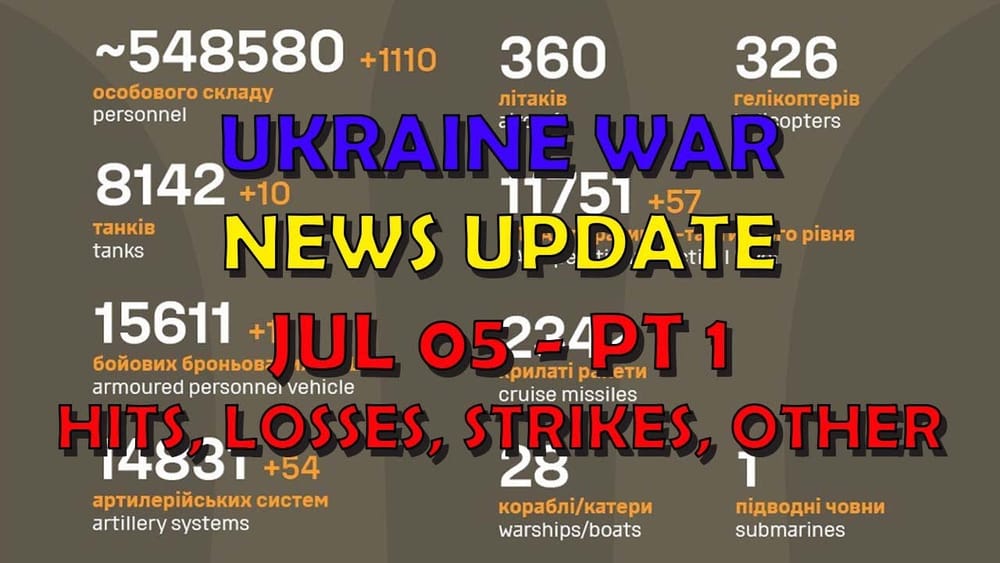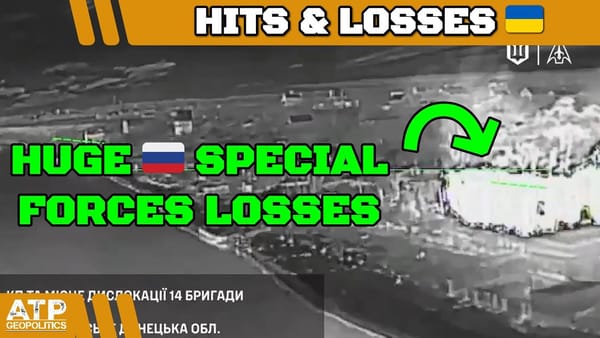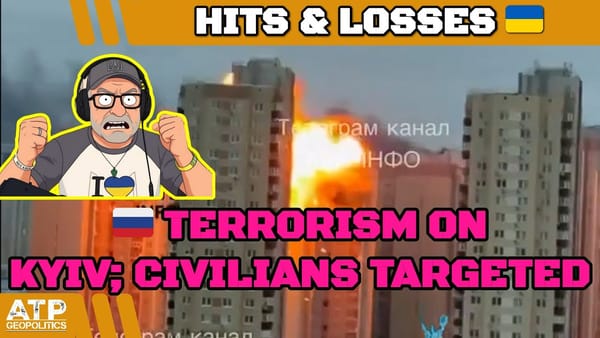Ukraine War Update NEWS: Pt 1 - Overnight & Other News
Table of Contents 📖
"They might be making those grinding gains. They might be having more gains now than they were having previously, but that comes at a huge cost and it might leave them somewhat weaker to Ukrainian counter-offenses going forward."
Hello Team
🎦 00:00-00:22⏩
Jonathan welcomes viewers to another video, noting it's the first part of the Ukraine War News Update for 5th July 2024. He apologizes for the late upload, attributing it to staying up all night following the UK election.
Return to top⤴️
🪦 DISCLAIMER FOR GENERAL STAFF LOSSES DATA
- These are real people with real lives and real families who love them. Don’t let the numbers sap your humanity.
- These numbers probably aren’t accurate but they’re the best we have and we don’t need them to be accurate to be indicative of patterns of activity.
- All losses are estimates. Losses cannot be counted with accuracy because of the conditions on the ground.
- Both sides would see it to be of their advantage to minimize their own losses maximize the other side’s losses.
- Neither side releases their losses but we have enough transparency from the Ukrainian side to have confidence in they are indicative.
- Personnel losses are hard to count. If a soldier gets injured, heals up, and returns to the front line only to get injured again, is that one loss or two? Also, how to deal with losses from PMC’s or soldiers fighting with RF from occupied territories?
- Equipment losses are hard to count. If an AA complex involves several parts and one part gets disabled, is that a loss, or a fraction of a loss? If a tank gets disabled, repaired, back into the fight, then disabled again, is that one lost tank or two?
- All recorded losses are vulnerable to multiple reporting. We have already seen numerous cases of multiple drones in the air reporting the same loss from different angles as multiple engagements.
- Losses are not always reported on the same day they occurred. It is frequent that drone losses are reported at least 24 hours after other terrestrial equipment losses. Certain losses may not be reported for days or weeks for military intelligence reasons.
Ukrainian General Staff Reports Heavy Russian Losses
🎦 00:22-02:54⏩
Jonathan reviews the Ukrainian General Staff's report on Russian losses, emphasizing the figures are generally high. He highlights:
- 1,110 personnel lost
- 10 tanks lost (slightly above average)
- 11 armoured personnel vehicles (below average)
- 54 artillery systems lost (a consistently high number)
- 54 vehicles and fuel tanks lost
- 5 pieces of special equipment
Jonathan notes the significance of these losses for the Russian military's ability to maintain operations. He then compares Oryx's loss data, showcasing a 5:1 vehicle loss ratio (79 Russian vehicles lost to 15 Ukrainian) and a 3.5:1 combat loss ratio in favor of Ukraine. He concludes by saying these figures are encouraging for Ukraine, particularly after a challenging week.
Return to top⤴️
Analysis of Russian and Ukrainian Equipment Losses
🎦 02:54-05:45⏩
Jonathan delves into the specifics of equipment losses:
- Ukrainian losses: Two M777 howitzers (one destroyed by a Lancet drone, the other by Krasnopol laser-guided munitions), alongside losses from mines, shelling, drone bombs, and loitering munitions.
- Russian losses: Electronic warfare system, surveillance equipment, a boat, several D-20 and D-30 artillery pieces (Jonathan explains their prevalence on loss lists is likely due to their short range, requiring forward deployment), various damaged and destroyed tanks (including T-90s and T-72s), infantry fighting vehicles, armoured personnel carriers, a Tornado-U multiple launch rocket system, military trucks, night vision equipment, FPV drones, ATVs, and civilian vehicles.
He observes the high number of Russian trucks and artillery systems lost will significantly impact their logistics and combat capabilities. He also points out the effectiveness of Ukrainian tactics, as evidenced by the high number of destroyed (rather than just damaged) Russian vehicles.
Return to top⤴️
Atesh Resistance Group Claims Attack on Trans-Siberian Railway
🎦 05:45-06:25⏩
Jonathan reports on a claim from the Ukrainian resistance group Atesh, alleging they have blown up a section of the Trans-Siberian railway near Yekaterinburg. This railway is believed to be a crucial supply route for transporting North Korean weapons and ammunition to the front line. Footage purportedly showing the aftermath of an explosion on the railway is included, though Jonathan remains cautious about its authenticity.
Return to top⤴️
Conflicting Reports Surround Russian Mi-28 Helicopter Incident
🎦 06:25-07:38⏩
There are conflicting reports about an incident involving a Russian Mi-28 helicopter. Initial reports suggested a hard landing and subsequent fire. However, other sources, including local eyewitnesses, claim the helicopter collided with a drone. Jonathan notes the discrepancy between official Russian accounts, which often downplay losses or mishaps, and eyewitness reports.
Return to top⤴️
Ukraine Reports 100% Interception Rate of Russian Drones
🎦 07:38-09:12⏩
Jonathan shifts focus to drone warfare, stating Ukraine experienced a night without missile attacks but faced a wave of 32 Russian attack drones. Remarkably, Ukrainian air defences intercepted all 32 drones, demonstrating increased effectiveness in countering this threat. While intercepted, Jonathan emphasizes these drones still cause damage upon impact.
Return to top⤴️
Ukrainian Drone Strikes Target Rostov and Krasnodar
🎦 09:12-11:34⏩
Reports indicate Ukrainian forces launched up to 50 drones into Russian territory, with confirmed strikes in Rostov and Krasnodar. Russian sources claim to have shot down several drones; however, Jonathan expresses skepticism, citing previous instances where Russian claims of successful interceptions proved false. Footage shows explosions in Rostov, with speculation that an oil refinery or thermal power plant might have been hit. Additionally, a substation in the port of Promorskoe Akhtarsk in Krasnodar was hit, resulting in power and water outages. The Kerch Bridge also experienced multiple closures throughout the night, which Jonathan notes is not unusual. Unconfirmed reports suggest a missile strike near Sevastopol in Crimea.
Return to top⤴️
Possible S-400 Air Defence System Location Revealed
🎦 11:34-13:30⏩
Jonathan discusses Open Source Intelligence (OSINT) revealing potential locations of Russian military assets. Footage shows a fire at Cape Fearland in Crimea, a strategically important area often used for radar and air defence systems. Jonathan highlights the role of OSINT in identifying and confirming targets, although he acknowledges the Ukrainian military likely already possesses this information. He questions whether such public disclosures might prompt the Russians to relocate these assets. Specifically, an S-400 air defence system, previously identified via Google Earth imagery, was potentially located in the area of the fire.
Return to top⤴️
Ukraine Targets Russian Military Airfield and GRU Unit
🎦 13:30-16:51⏩
Further reports confirm Ukrainian strikes on a Russian military airfield at Primorsko-Akhtarsk. Sources suggest missiles and drones were involved, with one Russian serviceman reported wounded. Jonathan notes the Russians downplayed the severity of the attack. In another incident, Ukrainian drones targeted a GRU (Russian military intelligence) unit in the Stavropol region, approximately 450 kilometers from the front line. This attack highlights Ukraine's ability to strike deep within Russian territory. Due to the remoteness of some targets, visual confirmation of these strikes is often limited, suggesting many attacks go unreported.
Return to top⤴️
Patriot Systems Prove Effective Against Kinzhal Missiles
🎦 16:51-17:41⏩
A Ukrainian Air Force Colonel reveals that since the arrival of US-supplied Patriot air defence systems in May 2023, all Russian Kinzhal hypersonic missiles aimed at Kyiv have been intercepted. This success underscores the Patriot system's capability and diminishes the strategic significance of the Kinzhal. Jonathan suggests future use of Kinzhal missiles is more likely to target alternative high-value locations such as Lviv or Starokostyantyniv airbase.
Return to top⤴️
Russian Strikes Devastate Ukrainian Energy Infrastructure
🎦 17:41-20:02⏩
Jonathan highlights the dire situation facing Ukraine's energy infrastructure as winter approaches. Russian strikes have inflicted severe damage, raising concerns about heating and power shortages. Citing a report by Rob Lee, he reveals approximately 90% of DTEK's thermal power generation capacity has been destroyed or damaged over the past three months. DTEK, a private energy company, estimates restoration costs between $350 and $400 million. This poses a significant challenge for Ukraine, requiring them to prioritize the protection of essential infrastructure alongside military targets. Jonathan emphasizes the need for increased air defence capabilities to mitigate this vulnerability.
Return to top⤴️
Ukrainian Ports Experience Surge in Cargo Handling
🎦 20:02-21:01⏩
Despite the ongoing conflict, Ukrainian ports have seen a substantial 68% increase in cargo handling during the first half of 2024, reaching 52.7 million tons compared to 31.3 million tons during the same period in 2023. Agricultural products dominate exports, accounting for 63.5%. This positive development is attributed to increased traffic through the export corridor established along the Black Sea, bypassing the blockaded Ukrainian ports.
Return to top⤴️
Russia Increases Offensive Operations Amidst Expected F-16 Deliveries
🎦 21:01-22:43⏩
Jonathan discusses the recent escalation of Russian offensives along the eastern front line. Citing Ukrainian commander General Syrskyi, he suggests Russia aims to capitalize on the current operational landscape before the arrival of F-16 fighter jets and further Western military aid bolster Ukraine's capabilities. Jonathan agrees with this assessment, noting Russia is likely to achieve greater success now compared to six months from now. While acknowledging the challenges Ukraine faces, Jonathan emphasizes their success in inflicting heavy losses on Russian forces. He concludes that Russia's gains come at a significant cost and could potentially weaken their position against future Ukrainian counter-offensives.
Return to top⤴️
Wrap Up
🎦 22:43-22:52⏩
Jonathan concludes the video by thanking viewers for watching and encouraging them to like, subscribe, and share.
Return to top⤴️



